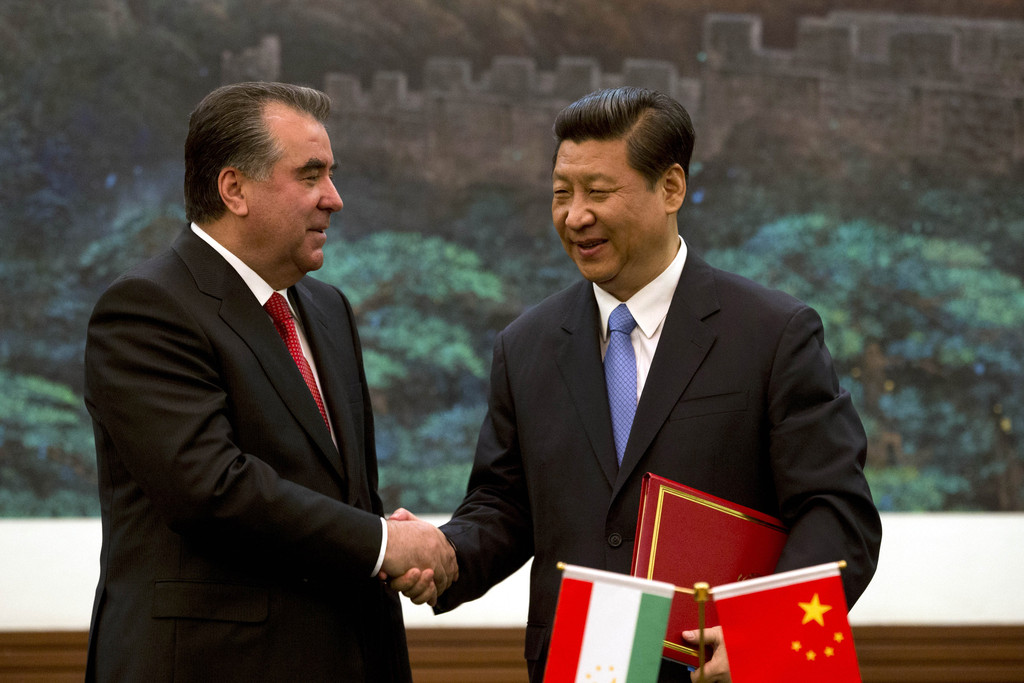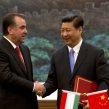
China as Tajikistan’s ‘Lender of Last Resort’
Publication: Eurasia Daily Monitor Volume: 10 Issue: 108
By:

On May 19–20, the President of Tajikistan Emomalii Rahmon paid a state visit to China where he had talks with his Chinese counterpart, Xi Jinping, and with several heads of Chinese state corporations. Rahmon’s official visit resulted in several multi-million-dollar investment projects in the infrastructure, banking, energy and mining sectors, as well as a technical cooperation agreement that altogether added up to around $200 million, thereby further strengthening China’s presence in Tajikistan’s economy (Ozodi, May 20).
During the first day of his visit, President Rahmon met with the heads of various Chinese state corporations, which shows the Central Asian leader’s particular interest in the further encouragement of Chinese investment and capital to Tajikistan. Besides the aforementioned multi-sector investment projects, Rahmon’s discussions with Chinese business leaders also focused on a planned enterprise for oil processing in Tajikistan (Asia Plus, May 20).
On May 20, during his top-level talks with President Xi, Rahmon highlighted that relations with China are a permanent priority in the foreign policy of Tajikistan. Furthermore, in order to bolster bilateral relations to a more strategic level, Rahmon proposed developing and adopting a “Multi-Dimensional Cooperation Program for the period of 2014–2019” between the two countries (Khovar, May 20).
Rahmon also held a separate meeting with Zhang Gaoli, the Chinese vice premier, on May 20. In his talks with Rahmon, Zhang made specific proposals for stepping up pragmatic bilateral cooperation and stated that: “China expects Tajikistan to create a good environment for Chinese businesses to invest and operate in the country” (Global Times, May 20). This proposal reflects the typical Chinese business expansion strategy based on its resource-driven foreign investment policy whereby loans and technical cooperation projects in foreign countries proceed in parallel with extensive investment in the development of minerals and energy industries. These bilateral relations are, arguably, based on mutual benefits—Tajikistan receives vital investment projects, long-term preferential loans and aid, whereas China gains access to Tajikistan’s minerals and energy sectors.
Most of Rahmon’s previous visits to China generally always resulted in several multi-million-dollar investment, loans and aid agreements, and the last visit was no exception. However, this most recent trip may also have other implications. Some analysts consider the timing of last month’s visit to have been strategically planned to fall on the eve of the forthcoming fall 2013 presidential election in Tajikistan. While others argue that Rahmon’s visit sought only to attract Chinese financial resources.
For instance, Kuban Abdimen, a Central Asia analyst from Kyrgyzstan, contends that the Tajikistani president’s recent trip to China was politically motivated to show that Dushanbe has flourishing relations with Beijing and that the Chinese leadership—particularly Xi, who came to power recently—supports the present leader of Tajikistan (Ozodi, May 20). Boris Shmelev, the director of the Center for Political Studies at the Institute of Economics in the Russian Academy of Science, also associates the visit with the forthcoming presidential election stating that: “Tajikistan has a devastating economic situation and the Tajik President does not have much room for [political] maneuver. So he has to play footsie [sic] with China because China provides financial resources, which can play an important role [in helping] the president to be re-elected to a new term” (https://www.aif.ru, May 13).
In contrast, the prominent analyst and Central Asian expert Jos Boonstra, a senior researcher at the European think tank FRIDE, linked Rahmon’s visit merely to its economic importance. According to Boonstra, Rahmon will win the upcoming presidential election even without political support from China. Likewise, Victor Dubovitsky, a Tajik history expert, also shares the same opinion and states that the visit was solely meant to attract Chinese investment and has nothing to do with the forthcoming election in Tajikistan (Ozodi, May 20).
Yet, despite from the short-term political and economic implications of this visit, the fast-growing Chinese capital expansion in Tajikistan is a subject of particular concern in Dushanbe. Notably, as of the first quarter of 2013, the total foreign debt of Tajikistan has reached $2.1 billion, out of which $862 million is owed to China, making this country the biggest lender to Tajikistan (Ozodagon, May 27). Chinese debt has been increasing substantially during the last few years. Since, 2008, it has more than quadrupled from that year’s level of $217 million (Eurasianet.org, February 7, 2008). The new investment and loan agreements, signed during Rahmon’s last visit to China, clearly further increase the total debt to this country.
Many experts thus warn of the risks of a mounting dependency on Chinese capital for Tajikistan. Moreover, some analysts point to the recent demarcation and delimitation of the border between two countries, when China received 1,100 square kilometers of Tajik territory, as an “unofficial debt writing-off agreement” with China. They warn that continuous borrowing from Beijing will end up with unpredictable outcomes in the long run, such as land, resources or invested property disputes. Nurali Davlat, a Tajikistani political scientist, pointed to past loans that China provided to African countries. When some of the African states were unable to repay these debts, China claimed the assets and properties that were constructed by Chinese investments in those countries. Tajikistan may also face such cases if the Central Asian republic is unable to pay the Chinese loans back, Davlat warned (Ozodagon, May 27).
On the other hand, cooperation with China has particular importance for Tajikistan because the latter’s foreign direct investment promotion policy has not resulted in the desired flow of FDI. International financial institutions and Western countries tend to link demands for political, economic and democratic reforms to promises of investment, while Russia uses its FDI policy as a political tool to pressure Tajikistan into various political and economic concessions. China, therefore, is always available as the “lender of last resort.”
Nevertheless, according to FRIDA researcher Boonstra, Tajikistan’s government—just like the public and the expert community—is also concerned about the increasing presence of Chinese capital in the country. Therefore Dushanbe seeks to cooperate with other major players in Central Asia such as Moscow, Washington, Tehran and others (Ozodi, May 20)—however these represent less immediate alternatives. In the short-run, additional loans, investment and aid are not only crucial to cope with Tajikistan’s unemployment, poverty and lack of FDI inflow, but also are vital for sustaining public trust in Rahmon’s government on the eve of the presidential election. Consequently, Tajikistan’s leadership has no choice but to attract as much Chinese investment and loans as possible, while neglecting the potential long-term threats. Tajikistan will need to be extremely careful that extensive borrowing from China does not one day result in new territorial disputes or takeovers of national resources by its powerful Asian neighbor.




